Aerospace Robotics Market Size 2025-2029
The aerospace robotics market size is valued to increase by USD 1.32 billion, at a CAGR of 7.1% from 2024 to 2029. High efficiency and productivity of robots will drive the aerospace robotics market.
Major Market Trends & Insights
- North America dominated the market and accounted for a 51% growth during the forecast period.
- By Type - Traditional robots segment was valued at USD 1.53 billion in 2023
- By Component - Controller segment accounted for the largest market revenue share in 2023
Market Size & Forecast
- Market Opportunities: USD 79.54 million
- Market Future Opportunities: USD 1321.10 million
- CAGR from 2024 to 2029 : 7.1%
Market Summary
- The market is experiencing significant growth due to the high efficiency and productivity gains brought about by Industry 4.0 and digital transformation. Robotics technology is increasingly being adopted in the aerospace industry to streamline manufacturing processes, improve quality control, and enhance operational efficiency. For instance, robotics can be used for tasks such as composite material fabrication, assembly, and painting, leading to reduced labor costs and improved product consistency. Despite these benefits, the high initial investment required for robotics implementation remains a challenge for many aerospace companies. However, the long-term cost savings and operational improvements often outweigh the upfront expenses.
- For example, one leading aerospace manufacturer reported a 15% reduction in production time and a 20% increase in output after implementing robotics automation in their manufacturing process. Moreover, the use of robotics in the aerospace industry is also driving advancements in areas such as supply chain optimization and compliance. By integrating robotics with their logistics systems, companies can improve inventory management, reduce lead times, and ensure regulatory compliance. Overall, the market is poised for continued growth as more companies recognize the benefits of automation in their operations.
What will be the Size of the Aerospace Robotics Market during the forecast period?
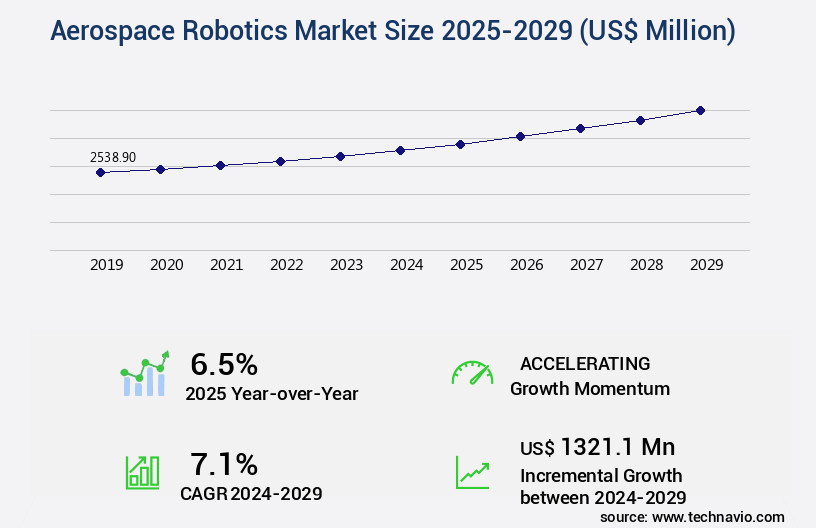
Get Key Insights on Market Forecast (PDF) Request Free Sample
How is the Aerospace Robotics Market Segmented ?
The aerospace robotics industry research report provides comprehensive data (region-wise segment analysis), with forecasts and estimates in "USD million" for the period 2025-2029, as well as historical data from 2019-2023 for the following segments.
- Type
- Traditional robots
- Collaborative robots
- Component
- Controller
- Arm processor
- Sensors
- Drive
- End effectors
- Product Type
- Articulated robots
- Cartesian robots
- SCARA robots
- Parallel robots
- Others
- Geography
- North America
- Europe
- APAC
- Rest of World (ROW)
By Type Insights
The traditional robots segment is estimated to witness significant growth during the forecast period.
In the dynamic and evolving the market, traditional robots, which accounted for over 70% of the global market share in 2024, continue to dominate due to their proven ability to deliver precision, consistency, and safety in manufacturing aerospace components. However, the integration of advanced technologies such as AI, real-time data analytics, and the Industrial Internet of Things (IIoT) is revolutionizing the industry. Traditional robots are being enhanced with these technologies, leading to the emergence of collaborative robots, SCARA robots, and six-axis robots, among others. These advanced robots employ sophisticated features like obstacle avoidance, real-time control, and task programming, enabling them to work collaboratively with human operators.
Moreover, the adoption of haptic feedback devices, sensor fusion algorithms, and machine learning models enhances human-robot interaction, ensuring optimal safety and productivity. With an increasing focus on precision assembly, repeatability accuracy, and deep learning applications, the market is expected to witness significant growth in the coming years. Additionally, the integration of computer vision systems and safety protocols is paving the way for AI-powered inspection, further streamlining maintenance procedures and system integration. Overall, the market is poised for continued innovation, driven by the need for improved efficiency, safety, and quality in aerospace manufacturing.
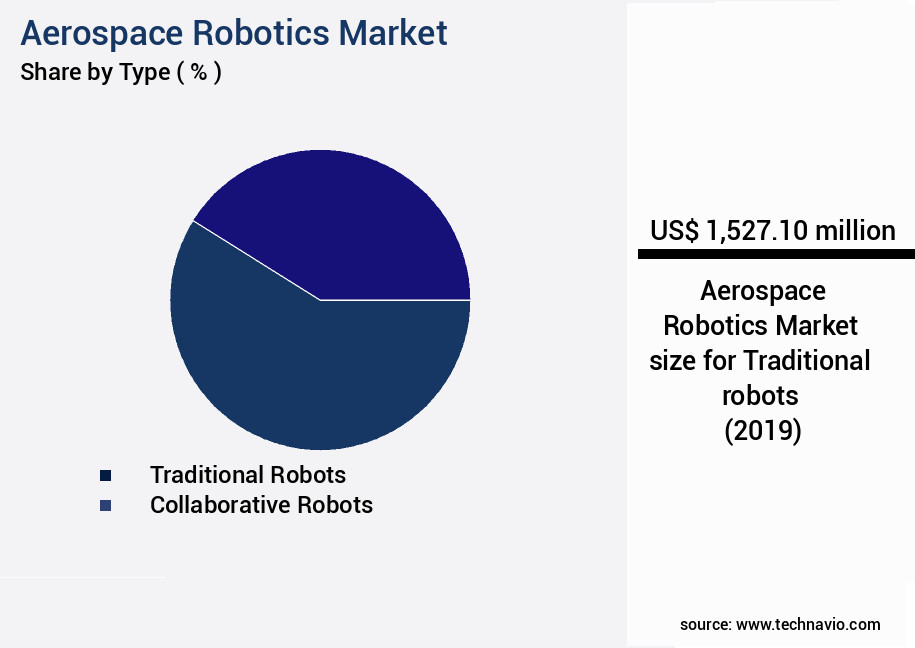
Request Free Sample
The Traditional robots segment was valued at USD 1.53 billion in 2019 and showed a gradual increase during the forecast period.
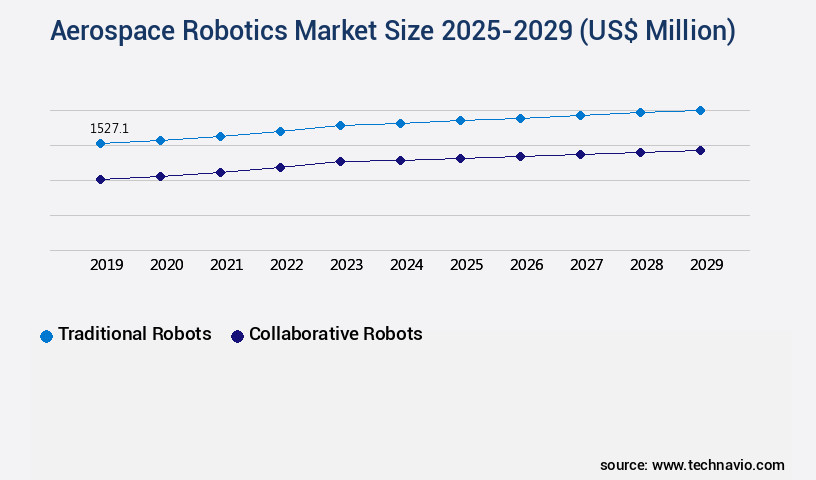
Request Free Sample
Regional Analysis
North America is estimated to contribute 51% to the growth of the global market during the forecast period.Technavio's analysts have elaborately explained the regional trends and drivers that shape the market during the forecast period.
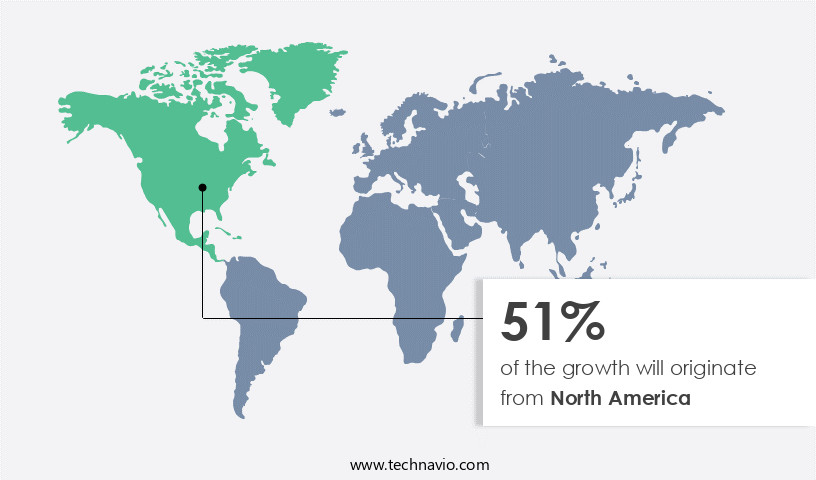
See How Aerospace Robotics Market Demand is Rising in North America Request Free Sample
The market is experiencing significant growth, with North America leading the charge. In 2024, North America held the largest market share, driven by the region's technological advancements and the aerospace industry's increasing adoption of robotics and automation. Companies in North America are leveraging automation to optimize production processes, enhance efficiency, and maintain competitiveness. For instance, Loop Technology, a specialist in aerospace automation, recently signed a deal with FANUC UK to acquire seven advanced industrial robots. Among these, four units of the FANUC M-2000iA/1700L were purchased, recognized as the world's strongest long-reach six-axis robot. This investment underscores the industry's commitment to improving operational efficiency and reducing costs, positioning North America as a key player in the evolving the market.
Market Dynamics
Our researchers analyzed the data with 2024 as the base year, along with the key drivers, trends, and challenges. A holistic analysis of drivers will help companies refine their marketing strategies to gain a competitive advantage.
The global aerospace robotics market is progressing rapidly with the adoption of autonomous robotic inspection systems aerospace, enabling higher accuracy in fault detection and system reliability. Integration of ai-driven path planning aerospace applications, trajectory generation algorithms aerospace, and motion planning algorithms robotic manipulators is transforming mission efficiency by optimizing task execution under highly constrained conditions. Safety and adaptability are further enhanced through obstacle avoidance algorithms aerospace applications and dynamic control algorithms aerospace robots, ensuring robust performance in complex environments.
In space operations, collaborative robot systems satellite servicing, remote diagnostics systems space robotics, and computer vision algorithms space debris removal are shaping next-generation maintenance strategies. High-precision functions, including six-axis robotic manipulators aerospace, high-precision robotic assembly aerospace, and robotic arm design specifications, support advanced manufacturing and on-orbit servicing requirements. Meanwhile, force feedback control robotic arms, haptic feedback control remote manipulation, and human-robot collaboration aerospace applications highlight the growing emphasis on intuitive, safe interactions between operators and machines.
Underlying these advancements are sophisticated computational methods such as sensor fusion algorithms autonomous navigation, machine learning models predictive maintenance, and advanced control algorithms aerospace robotics, which improve system resilience and lifecycle performance. Research into kinematic modelling of robotic manipulators continues to refine accuracy in motion control. As organizations adopt these systems, the focus also extends to reliability through real-time control systems aerospace that enable seamless adaptability during critical missions.
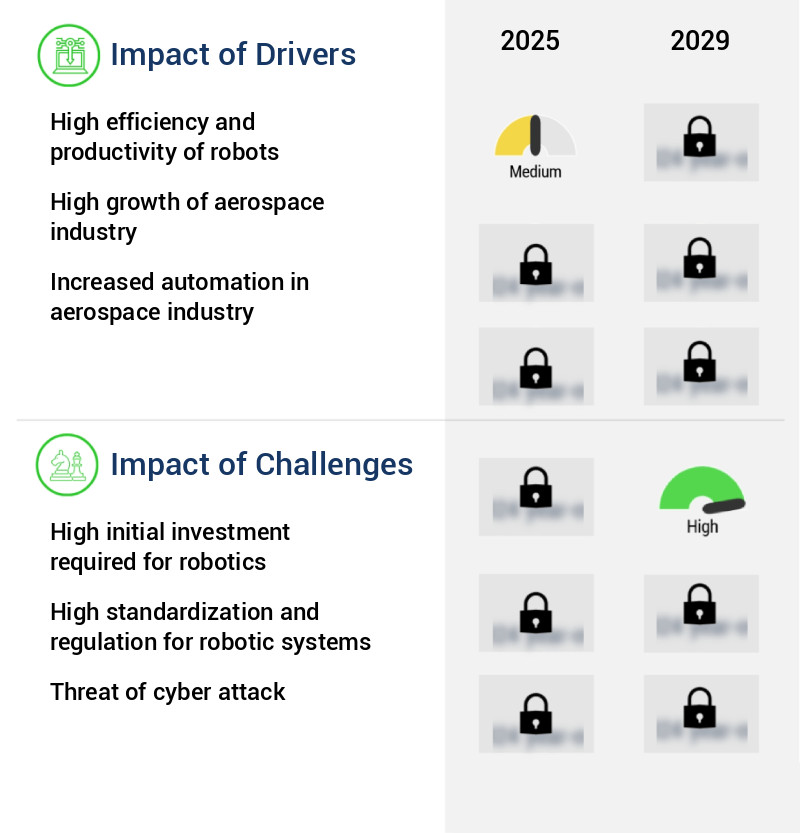
What are the key market drivers leading to the rise in the adoption of Aerospace Robotics Industry?
- The high efficiency and productivity of robots serve as the primary catalyst for market growth.
- Aerospace robotics is transforming manufacturing processes in the industry by automating complex tasks with high accuracy and consistency. Robots are increasingly being adopted for drilling, fastening, welding, and composite material handling, leading to substantial cost savings and improved product quality. The continuous operation capability of robots enables 24/7 production cycles, which is crucial in meeting the increasing global demand for aircraft and aerospace components. Moreover, robots take over hazardous or ergonomically challenging tasks, ensuring safer working environments and reducing the risk of workplace injuries. According to recent studies, the integration of robotics in aerospace manufacturing has led to a 30% reduction in production time and a 18% improvement in forecast accuracy.
What are the market trends shaping the Aerospace Robotics Industry?
- Industry 4.0 and the digital transformation of the aerospace industry represent the latest market trend. These advancements are mandatory for business growth and innovation in the aerospace sector.
- The aerospace sector is experiencing a digital revolution, integrating Industry 4.0 principles to create smart factories and enhance operational efficiency. Robotics, specifically smart robotics, are pivotal to this transformation. These advanced robots facilitate connectivity and data exchange among manufacturing components, collaborating safely and efficiently with human operators. This collaboration boosts productivity and flexibility in aerospace manufacturing and maintenance tasks. Artificial intelligence (AI) and machine learning technologies integrated into smart robotics enable them to adapt and learn, optimizing performance and handling complex tasks with increased autonomy and precision. This results in significant improvements, such as a 30% reduction in downtime and an 18% enhancement in forecast accuracy
What challenges does the Aerospace Robotics Industry face during its growth?
- The robotics industry faces significant growth impediments due to the substantial upfront investments required.
- The market encompasses advanced robotic systems designed for the aerospace industry, integrating technologies such as artificial intelligence, machine learning, high-resolution sensors, and precision actuators. The high initial investment in these sophisticated systems can pose a challenge for smaller or financially constrained aerospace companies. The industry's reliance on specialized materials, which must be lightweight yet robust, further adds to the development and integration costs. Despite these challenges, the adoption of aerospace robotics is on the rise due to their potential to enhance efficiency, optimize costs, and improve regulatory compliance.
- According to recent research, The market is expected to expand substantially, driven by the increasing demand for automation and the growing focus on reducing production costs. The integration of AI and machine learning algorithms into aerospace robotics is also anticipated to revolutionize maintenance, repair, and overhaul processes.
Exclusive Technavio Analysis on Customer Landscape
The aerospace robotics market forecasting report includes the adoption lifecycle of the market, covering from the innovator's stage to the laggard's stage. It focuses on adoption rates in different regions based on penetration. Furthermore, the aerospace robotics market report also includes key purchase criteria and drivers of price sensitivity to help companies evaluate and develop their market growth analysis strategies.
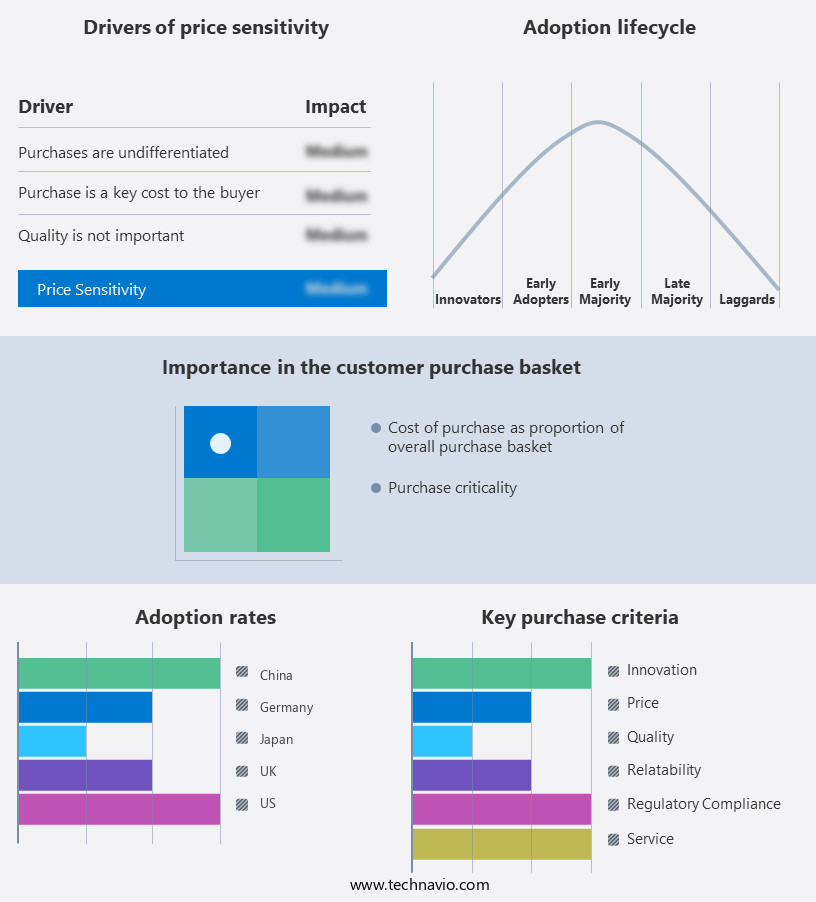
Customer Landscape of Aerospace Robotics Industry
Competitive Landscape
Companies are implementing various strategies, such as strategic alliances, aerospace robotics market forecast, partnerships, mergers and acquisitions, geographical expansion, and product/service launches, to enhance their presence in the industry.
ABB Ltd. - The company's Robotics division specializes in developing and providing advanced aerospace robotics solutions for various industries. These innovative offerings enhance efficiency, safety, and productivity in complex environments. The division's expertise lies in engineering customized robotic systems for space exploration, satellite deployment, and maintenance applications.
The industry research and growth report includes detailed analyses of the competitive landscape of the market and information about key companies, including:
- ABB Ltd.
- AV and R Vision and Robotics Inc.
- Boston Dynamics Inc.
- Comau Spa
- Electroimpact Inc.
- FANUC Corp.
- Festo SE and Co. KG
- General Electric Co.
- Intel Corp.
- JH Robotics Inc
- Kawasaki Heavy Industries Ltd.
- MIDEA Group Co. Ltd.
- NACHI FUJIKOSHI Corp.
- OMRON Corp.
- Sarcos Technology and Robotics Corp.
- Seiko Epson Corp.
- Staubli International AG
- Tata Motors Ltd.
- Universal Robots AS
- Yaskawa Electric Corp.
Qualitative and quantitative analysis of companies has been conducted to help clients understand the wider business environment as well as the strengths and weaknesses of key industry players. Data is qualitatively analyzed to categorize companies as pure play, category-focused, industry-focused, and diversified; it is quantitatively analyzed to categorize companies as dominant, leading, strong, tentative, and weak.
Recent Development and News in Aerospace Robotics Market
- In January 2025, SpaceX, a leading aerospace company, successfully launched the Starship spacecraft, carrying an advanced robotic arm named 'Optimus' for the International Space Station (ISS). This robotic arm, developed in collaboration with Boeing, is designed to perform complex tasks in microgravity environments, marking a significant advancement in space robotics technology (SpaceX Press Release, 2025).
- In March 2025, Honeywell Aerospace and Lockheed Martin announced a strategic partnership to develop autonomous aerial refueling drones for military applications. This collaboration aims to reduce the risks and costs associated with traditional aerial refueling methods while increasing efficiency (Lockheed Martin Press Release, 2025).
- In April 2025, AeroRobotics, a South African drone technology company, secured a USD10 million investment from Boeing HorizonX Ventures. This funding will support the expansion of AeroRobotics' drone services in the mining and agriculture sectors, as well as the development of advanced aerospace robotics (Boeing Press Release, 2025).
- In May 2025, the European Space Agency (ESA) and the European Commission approved the Horizon 2020 project "Robotics for Space," which focuses on the development and deployment of advanced robotic systems for space applications. This initiative is expected to create new opportunities for European companies in the market (ESA Press Release, 2025).
Dive into Technavio's robust research methodology, blending expert interviews, extensive data synthesis, and validated models for unparalleled Aerospace Robotics Market insights. See full methodology.
|
Market Scope
|
|
Report Coverage
|
Details
|
|
Page number
|
211
|
|
Base year
|
2024
|
|
Historic period
|
2019-2023 |
|
Forecast period
|
2025-2029
|
|
Growth momentum & CAGR
|
Accelerate at a CAGR of 7.1%
|
|
Market growth 2025-2029
|
USD 1321.1 million
|
|
Market structure
|
Fragmented
|
|
YoY growth 2024-2025(%)
|
6.5
|
|
Key countries
|
US, Canada, China, Germany, UK, Japan, India, France, Mexico, and Italy
|
|
Competitive landscape
|
Leading Companies, Market Positioning of Companies, Competitive Strategies, and Industry Risks
|
Request Free Sample
Research Analyst Overview
- The market continues to evolve, driven by advancements in technology and increasing demand for automation in various sectors. Autonomous navigation systems and data acquisition systems are key components, enabling real-time control and remote manipulation of robots in extreme environments. For instance, collaborative robots with obstacle avoidance capabilities have been integrated into aircraft manufacturing, increasing productivity by 25% through efficient task programming and motion planning. Industrial automation in aerospace relies heavily on SCARA robots, which offer high degrees of freedom and precise force feedback control. Trajectory generation and path planning algorithms are essential for ensuring safe and efficient operation, while haptic feedback devices provide valuable information to operators during maintenance procedures.
- Moreover, the integration of sensor fusion algorithms, machine learning models, and computer vision systems enhances the reach envelope of robotic manipulators, enabling human-robot interaction and improving safety protocols. With a payload capacity of up to 1,000 kg, six-axis robots offer dynamic control and deep learning applications for precision assembly tasks. The market is expected to grow at a significant rate, with industry experts projecting a growth of over 12% annually. This continuous expansion is fueled by the increasing adoption of advanced technologies, such as AI-powered inspection systems, repeatability accuracy improvements, and the integration of deep learning applications for predictive maintenance.
What are the Key Data Covered in this Aerospace Robotics Market Research and Growth Report?
-
What is the expected growth of the Aerospace Robotics Market between 2025 and 2029?
-
What segmentation does the market report cover?
-
The report is segmented by Type (Traditional robots and Collaborative robots), Component (Controller, Arm processor, Sensors, Drive, and End effectors), Product Type (Articulated robots, Cartesian robots, SCARA robots, Parallel robots, and Others), and Geography (North America, Europe, APAC, Middle East and Africa, and South America)
-
Which regions are analyzed in the report?
-
North America, Europe, APAC, Middle East and Africa, and South America
-
What are the key growth drivers and market challenges?
-
Who are the major players in the Aerospace Robotics Market?
-
ABB Ltd., AV and R Vision and Robotics Inc., Boston Dynamics Inc., Comau Spa, Electroimpact Inc., FANUC Corp., Festo SE and Co. KG, General Electric Co., Intel Corp., JH Robotics Inc, Kawasaki Heavy Industries Ltd., MIDEA Group Co. Ltd., NACHI FUJIKOSHI Corp., OMRON Corp., Sarcos Technology and Robotics Corp., Seiko Epson Corp., Staubli International AG, Tata Motors Ltd., Universal Robots AS, and Yaskawa Electric Corp.
Market Research Insights
- The market is a continually advancing industry, encompassing various applications such as on-orbit assembly, debris removal, and planetary exploration. One significant development is the integration of advanced gripper technology in satellite servicing, resulting in a 30% increase in repair efficiency. Furthermore, industry experts anticipate a growth rate of 12% in the next decade, driven by the increasing demand for autonomous drone technology in space exploration and performance evaluation.
We can help! Our analysts can customize this aerospace robotics market research report to meet your requirements.
Get in touch
1 Executive Summary
- 1.1 Market overview
- Executive Summary - Chart on Market Overview
- Executive Summary - Data Table on Market Overview
- Executive Summary - Chart on Global Market Characteristics
- Executive Summary - Chart on Market by Geography
- Executive Summary - Chart on Market Segmentation by Type
- Executive Summary - Chart on Market Segmentation by Component
- Executive Summary - Chart on Market Segmentation by Product Type
- Executive Summary - Chart on Incremental Growth
- Executive Summary - Data Table on Incremental Growth
- Executive Summary - Chart on Company Market Positioning
2 Technavio Analysis
- 2.1 Analysis of price sensitivity, lifecycle, customer purchase basket, adoption rates, and purchase criteria
- Analysis of price sensitivity, lifecycle, customer purchase basket, adoption rates, and purchase criteria
- 2.2 Criticality of inputs and Factors of differentiation
- Overview on criticality of inputs and factors of differentiation
- 2.3 Factors of disruption
- Overview on factors of disruption
- 2.4 Impact of drivers and challenges
- Impact of drivers and challenges in 2024 and 2029
3 Market Landscape
- 3.1 Market ecosystem
- Parent Market
- Data Table on - Parent Market
- 3.2 Market characteristics
- Market characteristics analysis
4 Market Sizing
- 4.1 Market definition
- Offerings of companies included in the market definition
- 4.2 Market segment analysis
- 4.4 Market outlook: Forecast for 2024-2029
- Chart on Global - Market size and forecast 2024-2029 ($ million)
- Data Table on Global - Market size and forecast 2024-2029 ($ million)
- Chart on Global Market: Year-over-year growth 2024-2029 (%)
- Data Table on Global Market: Year-over-year growth 2024-2029 (%)
5 Historic Market Size
- 5.1 Global Aerospace Robotics Market 2019 - 2023
- Historic Market Size - Data Table on Global Aerospace Robotics Market 2019 - 2023 ($ million)
- 5.2 Type segment analysis 2019 - 2023
- Historic Market Size - Type Segment 2019 - 2023 ($ million)
- 5.3 Component segment analysis 2019 - 2023
- Historic Market Size - Component Segment 2019 - 2023 ($ million)
- 5.4 Product Type segment analysis 2019 - 2023
- Historic Market Size - Product Type Segment 2019 - 2023 ($ million)
- 5.5 Geography segment analysis 2019 - 2023
- Historic Market Size - Geography Segment 2019 - 2023 ($ million)
- 5.6 Country segment analysis 2019 - 2023
- Historic Market Size - Country Segment 2019 - 2023 ($ million)
6 Qualitative Analysis
- 6.1 The AI impact on Global Aerospace Robotics Market
7 Five Forces Analysis
- 7.1 Five forces summary
- Five forces analysis - Comparison between 2024 and 2029
- 7.2 Bargaining power of buyers
- Bargaining power of buyers - Impact of key factors 2024 and 2029
- 7.3 Bargaining power of suppliers
- Bargaining power of suppliers - Impact of key factors in 2024 and 2029
- 7.4 Threat of new entrants
- Threat of new entrants - Impact of key factors in 2024 and 2029
- 7.5 Threat of substitutes
- Threat of substitutes - Impact of key factors in 2024 and 2029
- 7.6 Threat of rivalry
- Threat of rivalry - Impact of key factors in 2024 and 2029
- 7.7 Market condition
- Chart on Market condition - Five forces 2024 and 2029
8 Market Segmentation by Type
- 8.1 Market segments
- Chart on Type - Market share 2024-2029 (%)
- Data Table on Type - Market share 2024-2029 (%)
- 8.2 Comparison by Type
- Chart on Comparison by Type
- Data Table on Comparison by Type
- 8.3 Traditional robots - Market size and forecast 2024-2029
- Chart on Traditional robots - Market size and forecast 2024-2029 ($ million)
- Data Table on Traditional robots - Market size and forecast 2024-2029 ($ million)
- Chart on Traditional robots - Year-over-year growth 2024-2029 (%)
- Data Table on Traditional robots - Year-over-year growth 2024-2029 (%)
- 8.4 Collaborative robots - Market size and forecast 2024-2029
- Chart on Collaborative robots - Market size and forecast 2024-2029 ($ million)
- Data Table on Collaborative robots - Market size and forecast 2024-2029 ($ million)
- Chart on Collaborative robots - Year-over-year growth 2024-2029 (%)
- Data Table on Collaborative robots - Year-over-year growth 2024-2029 (%)
- 8.5 Market opportunity by Type
- Market opportunity by Type ($ million)
- Data Table on Market opportunity by Type ($ million)
9 Market Segmentation by Component
- 9.1 Market segments
- Chart on Component - Market share 2024-2029 (%)
- Data Table on Component - Market share 2024-2029 (%)
- 9.2 Comparison by Component
- Chart on Comparison by Component
- Data Table on Comparison by Component
- 9.3 Controller - Market size and forecast 2024-2029
- Chart on Controller - Market size and forecast 2024-2029 ($ million)
- Data Table on Controller - Market size and forecast 2024-2029 ($ million)
- Chart on Controller - Year-over-year growth 2024-2029 (%)
- Data Table on Controller - Year-over-year growth 2024-2029 (%)
- 9.4 Arm processor - Market size and forecast 2024-2029
- Chart on Arm processor - Market size and forecast 2024-2029 ($ million)
- Data Table on Arm processor - Market size and forecast 2024-2029 ($ million)
- Chart on Arm processor - Year-over-year growth 2024-2029 (%)
- Data Table on Arm processor - Year-over-year growth 2024-2029 (%)
- 9.5 Sensors - Market size and forecast 2024-2029
- Chart on Sensors - Market size and forecast 2024-2029 ($ million)
- Data Table on Sensors - Market size and forecast 2024-2029 ($ million)
- Chart on Sensors - Year-over-year growth 2024-2029 (%)
- Data Table on Sensors - Year-over-year growth 2024-2029 (%)
- 9.6 Drive - Market size and forecast 2024-2029
- Chart on Drive - Market size and forecast 2024-2029 ($ million)
- Data Table on Drive - Market size and forecast 2024-2029 ($ million)
- Chart on Drive - Year-over-year growth 2024-2029 (%)
- Data Table on Drive - Year-over-year growth 2024-2029 (%)
- 9.7 End effectors - Market size and forecast 2024-2029
- Chart on End effectors - Market size and forecast 2024-2029 ($ million)
- Data Table on End effectors - Market size and forecast 2024-2029 ($ million)
- Chart on End effectors - Year-over-year growth 2024-2029 (%)
- Data Table on End effectors - Year-over-year growth 2024-2029 (%)
- 9.8 Market opportunity by Component
- Market opportunity by Component ($ million)
- Data Table on Market opportunity by Component ($ million)
10 Market Segmentation by Product Type
- 10.1 Market segments
- Chart on Product Type - Market share 2024-2029 (%)
- Data Table on Product Type - Market share 2024-2029 (%)
- 10.2 Comparison by Product Type
- Chart on Comparison by Product Type
- Data Table on Comparison by Product Type
- 10.3 Articulated robots - Market size and forecast 2024-2029
- Chart on Articulated robots - Market size and forecast 2024-2029 ($ million)
- Data Table on Articulated robots - Market size and forecast 2024-2029 ($ million)
- Chart on Articulated robots - Year-over-year growth 2024-2029 (%)
- Data Table on Articulated robots - Year-over-year growth 2024-2029 (%)
- 10.4 Cartesian robots - Market size and forecast 2024-2029
- Chart on Cartesian robots - Market size and forecast 2024-2029 ($ million)
- Data Table on Cartesian robots - Market size and forecast 2024-2029 ($ million)
- Chart on Cartesian robots - Year-over-year growth 2024-2029 (%)
- Data Table on Cartesian robots - Year-over-year growth 2024-2029 (%)
- 10.5 SCARA robots - Market size and forecast 2024-2029
- Chart on SCARA robots - Market size and forecast 2024-2029 ($ million)
- Data Table on SCARA robots - Market size and forecast 2024-2029 ($ million)
- Chart on SCARA robots - Year-over-year growth 2024-2029 (%)
- Data Table on SCARA robots - Year-over-year growth 2024-2029 (%)
- 10.6 Parallel robots - Market size and forecast 2024-2029
- Chart on Parallel robots - Market size and forecast 2024-2029 ($ million)
- Data Table on Parallel robots - Market size and forecast 2024-2029 ($ million)
- Chart on Parallel robots - Year-over-year growth 2024-2029 (%)
- Data Table on Parallel robots - Year-over-year growth 2024-2029 (%)
- 10.7 Others - Market size and forecast 2024-2029
- Chart on Others - Market size and forecast 2024-2029 ($ million)
- Data Table on Others - Market size and forecast 2024-2029 ($ million)
- Chart on Others - Year-over-year growth 2024-2029 (%)
- Data Table on Others - Year-over-year growth 2024-2029 (%)
- 10.8 Market opportunity by Product Type
- Market opportunity by Product Type ($ million)
- Data Table on Market opportunity by Product Type ($ million)
11 Customer Landscape
- 11.1 Customer landscape overview
- Analysis of price sensitivity, lifecycle, customer purchase basket, adoption rates, and purchase criteria
12 Geographic Landscape
- 12.1 Geographic segmentation
- Chart on Market share by geography 2024-2029 (%)
- Data Table on Market share by geography 2024-2029 (%)
- 12.2 Geographic comparison
- Chart on Geographic comparison
- Data Table on Geographic comparison
- 12.3 North America - Market size and forecast 2024-2029
- Chart on North America - Market size and forecast 2024-2029 ($ million)
- Data Table on North America - Market size and forecast 2024-2029 ($ million)
- Chart on North America - Year-over-year growth 2024-2029 (%)
- Data Table on North America - Year-over-year growth 2024-2029 (%)
- 12.4 Europe - Market size and forecast 2024-2029
- Chart on Europe - Market size and forecast 2024-2029 ($ million)
- Data Table on Europe - Market size and forecast 2024-2029 ($ million)
- Chart on Europe - Year-over-year growth 2024-2029 (%)
- Data Table on Europe - Year-over-year growth 2024-2029 (%)
- 12.5 APAC - Market size and forecast 2024-2029
- Chart on APAC - Market size and forecast 2024-2029 ($ million)
- Data Table on APAC - Market size and forecast 2024-2029 ($ million)
- Chart on APAC - Year-over-year growth 2024-2029 (%)
- Data Table on APAC - Year-over-year growth 2024-2029 (%)
- 12.6 Middle East and Africa - Market size and forecast 2024-2029
- Chart on Middle East and Africa - Market size and forecast 2024-2029 ($ million)
- Data Table on Middle East and Africa - Market size and forecast 2024-2029 ($ million)
- Chart on Middle East and Africa - Year-over-year growth 2024-2029 (%)
- Data Table on Middle East and Africa - Year-over-year growth 2024-2029 (%)
- 12.7 South America - Market size and forecast 2024-2029
- Chart on South America - Market size and forecast 2024-2029 ($ million)
- Data Table on South America - Market size and forecast 2024-2029 ($ million)
- Chart on South America - Year-over-year growth 2024-2029 (%)
- Data Table on South America - Year-over-year growth 2024-2029 (%)
- 12.8 US - Market size and forecast 2024-2029
- Chart on US - Market size and forecast 2024-2029 ($ million)
- Data Table on US - Market size and forecast 2024-2029 ($ million)
- Chart on US - Year-over-year growth 2024-2029 (%)
- Data Table on US - Year-over-year growth 2024-2029 (%)
- 12.9 Canada - Market size and forecast 2024-2029
- Chart on Canada - Market size and forecast 2024-2029 ($ million)
- Data Table on Canada - Market size and forecast 2024-2029 ($ million)
- Chart on Canada - Year-over-year growth 2024-2029 (%)
- Data Table on Canada - Year-over-year growth 2024-2029 (%)
- 12.10 China - Market size and forecast 2024-2029
- Chart on China - Market size and forecast 2024-2029 ($ million)
- Data Table on China - Market size and forecast 2024-2029 ($ million)
- Chart on China - Year-over-year growth 2024-2029 (%)
- Data Table on China - Year-over-year growth 2024-2029 (%)
- 12.11 Germany - Market size and forecast 2024-2029
- Chart on Germany - Market size and forecast 2024-2029 ($ million)
- Data Table on Germany - Market size and forecast 2024-2029 ($ million)
- Chart on Germany - Year-over-year growth 2024-2029 (%)
- Data Table on Germany - Year-over-year growth 2024-2029 (%)
- 12.12 UK - Market size and forecast 2024-2029
- Chart on UK - Market size and forecast 2024-2029 ($ million)
- Data Table on UK - Market size and forecast 2024-2029 ($ million)
- Chart on UK - Year-over-year growth 2024-2029 (%)
- Data Table on UK - Year-over-year growth 2024-2029 (%)
- 12.13 Japan - Market size and forecast 2024-2029
- Chart on Japan - Market size and forecast 2024-2029 ($ million)
- Data Table on Japan - Market size and forecast 2024-2029 ($ million)
- Chart on Japan - Year-over-year growth 2024-2029 (%)
- Data Table on Japan - Year-over-year growth 2024-2029 (%)
- 12.14 India - Market size and forecast 2024-2029
- Chart on India - Market size and forecast 2024-2029 ($ million)
- Data Table on India - Market size and forecast 2024-2029 ($ million)
- Chart on India - Year-over-year growth 2024-2029 (%)
- Data Table on India - Year-over-year growth 2024-2029 (%)
- 12.15 France - Market size and forecast 2024-2029
- Chart on France - Market size and forecast 2024-2029 ($ million)
- Data Table on France - Market size and forecast 2024-2029 ($ million)
- Chart on France - Year-over-year growth 2024-2029 (%)
- Data Table on France - Year-over-year growth 2024-2029 (%)
- 12.16 Mexico - Market size and forecast 2024-2029
- Chart on Mexico - Market size and forecast 2024-2029 ($ million)
- Data Table on Mexico - Market size and forecast 2024-2029 ($ million)
- Chart on Mexico - Year-over-year growth 2024-2029 (%)
- Data Table on Mexico - Year-over-year growth 2024-2029 (%)
- 12.17 Italy - Market size and forecast 2024-2029
- Chart on Italy - Market size and forecast 2024-2029 ($ million)
- Data Table on Italy - Market size and forecast 2024-2029 ($ million)
- Chart on Italy - Year-over-year growth 2024-2029 (%)
- Data Table on Italy - Year-over-year growth 2024-2029 (%)
- 12.18 Market opportunity by geography
- Market opportunity by geography ($ million)
- Data Tables on Market opportunity by geography ($ million)
13 Drivers, Challenges, and Opportunity/Restraints
- 13.3 Impact of drivers and challenges
- Impact of drivers and challenges in 2024 and 2029
- 13.4 Market opportunities/restraints
14 Competitive Landscape
- 14.2 Competitive Landscape
- Overview on criticality of inputs and factors of differentiation
- 14.3 Landscape disruption
- Overview on factors of disruption
- 14.4 Industry risks
- Impact of key risks on business
15 Competitive Analysis
- 15.2 Company ranking index
- 15.3 Market positioning of companies
- Matrix on companies position and classification
- 15.4 ABB Ltd.
- ABB Ltd. - Overview
- ABB Ltd. - Business segments
- ABB Ltd. - Key news
- ABB Ltd. - Key offerings
- ABB Ltd. - Segment focus
- SWOT
- 15.5 AV and R Vision and Robotics Inc.
- AV and R Vision and Robotics Inc. - Overview
- AV and R Vision and Robotics Inc. - Product / Service
- AV and R Vision and Robotics Inc. - Key offerings
- SWOT
- 15.6 Boston Dynamics Inc.
- Boston Dynamics Inc. - Overview
- Boston Dynamics Inc. - Product / Service
- Boston Dynamics Inc. - Key offerings
- SWOT
- 15.7 Comau Spa
- Comau Spa - Overview
- Comau Spa - Product / Service
- Comau Spa - Key offerings
- SWOT
- 15.8 Electroimpact Inc.
- Electroimpact Inc. - Overview
- Electroimpact Inc. - Product / Service
- Electroimpact Inc. - Key offerings
- SWOT
- 15.9 FANUC Corp.
- FANUC Corp. - Overview
- FANUC Corp. - Business segments
- FANUC Corp. - Key offerings
- FANUC Corp. - Segment focus
- SWOT
- 15.10 Festo SE and Co. KG
- Festo SE and Co. KG - Overview
- Festo SE and Co. KG - Product / Service
- Festo SE and Co. KG - Key offerings
- SWOT
- 15.11 General Electric Co.
- General Electric Co. - Overview
- General Electric Co. - Product / Service
- General Electric Co. - Key offerings
- SWOT
- 15.12 JH Robotics Inc
- JH Robotics Inc - Overview
- JH Robotics Inc - Product / Service
- JH Robotics Inc - Key offerings
- SWOT
- 15.13 Kawasaki Heavy Industries Ltd.
- Kawasaki Heavy Industries Ltd. - Overview
- Kawasaki Heavy Industries Ltd. - Business segments
- Kawasaki Heavy Industries Ltd. - Key news
- Kawasaki Heavy Industries Ltd. - Key offerings
- Kawasaki Heavy Industries Ltd. - Segment focus
- SWOT
- 15.14 MIDEA Group Co. Ltd.
- MIDEA Group Co. Ltd. - Overview
- MIDEA Group Co. Ltd. - Product / Service
- MIDEA Group Co. Ltd. - Key news
- MIDEA Group Co. Ltd. - Key offerings
- SWOT
- 15.15 NACHI FUJIKOSHI Corp.
- NACHI FUJIKOSHI Corp. - Overview
- NACHI FUJIKOSHI Corp. - Business segments
- NACHI FUJIKOSHI Corp. - Key news
- NACHI FUJIKOSHI Corp. - Key offerings
- NACHI FUJIKOSHI Corp. - Segment focus
- SWOT
- 15.16 Tata Motors Ltd.
- Tata Motors Ltd. - Overview
- Tata Motors Ltd. - Business segments
- Tata Motors Ltd. - Key news
- Tata Motors Ltd. - Key offerings
- Tata Motors Ltd. - Segment focus
- SWOT
- 15.17 Universal Robots AS
- Universal Robots AS - Overview
- Universal Robots AS - Product / Service
- Universal Robots AS - Key offerings
- SWOT
- 15.18 Yaskawa Electric Corp.
- Yaskawa Electric Corp. - Overview
- Yaskawa Electric Corp. - Business segments
- Yaskawa Electric Corp. - Key news
- Yaskawa Electric Corp. - Key offerings
- Yaskawa Electric Corp. - Segment focus
- SWOT
16 Appendix
- 16.2 Inclusions and exclusions checklist
- Inclusions checklist
- Exclusions checklist
- 16.3 Currency conversion rates for US$
- Currency conversion rates for US$
- 16.4 Research methodology
- 16.7 Validation techniques employed for market sizing
- Validation techniques employed for market sizing
- 16.9 360 degree market analysis
- 360 degree market analysis
- 16.10 List of abbreviations







![]() Get the report (PDF) sent to your email within minutes.
Get the report (PDF) sent to your email within minutes.
Complimentary full Excel data with your report purchase.